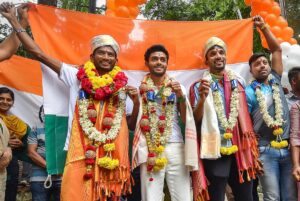India’s rise in Olympic sports is a result of government and corporates working in tandem

The ovation received by the successful Indian contingent in the recently concluded Commonwealth Games and the manner in which crowds thronged to see the matches at Chess Olympiad 2022 and cheered the chess-players is a testimony to the fact that India is gradually morphing into a comprehensive sports-loving nation — one that embraces all sports and not just cricket. The crowds had much to cheer about. A rich haul of 61 medals in the recent CWG, of which 22 were gold, was the best-ever performance in a CWG excluding shooting. In chess, India has a long pipeline of potential Grandmasters. If performance has seen a turnaround, so has spectator interest and a willingness by youngsters to look upon sports as a career. In this transformation, private sector involvement as well as some innovative policy and management styles have played a part. There are funds flowing in, and these are being used sensibly. India’s sports sector which includes sporting events, sport goods manufacturing and nutraceuticals is expected to grow to $100 billion by 2027 from $27 billion in 2020.
On the policy front, the Centre’s Khelo India scheme has made a mark, with States such as Odisha, Jharkhand, Haryana, Chhattisgarh and Karnataka too realising the worth of pushing money into sports. The Budgetary allocation for youth affairs and sports has been consistently revised higher since 2014-15 and stands at ₹3,062 crore in 2022-23, not big but certainly growing. Almost a third of this budget has been set aside for the Khelo India scheme which operates 523 centres for identifying talent, 247 academies for training the sportspeople and 29 centres of excellence for more intensive training. The development of sporting infrastructure in remote regions such as Bastar (Chattisgarh) or Pulwama district of Jammu and Kashmir is notable. The Centre and States have come to realise the prestige and visibility that accrue to a region from fairly moderate levels of investment. Corporates too have figured this out from the IPL model. As a result, a sort of PPP model involving Target Olympic Podium Scheme of the Sports Authority of India, along with corporate houses and games federations, have honed skills at talent spotting, cutting through layers of cussed officialdom and going straight to the field, as it were. In the technology age, this task has become easier. Coaches have been incentivised. What is now unfolding marks a break from the past, when a feudal nexus of politicians and bureaucrats would ensure that most talent would never get its due. Though that nexus is not fully broken yet, private participation has infused professionalism and money. Those picked are well managed, not just in terms of their diet and training but also their psychological needs. Athletics and games such as chess have become viable career options thanks to corporate sponsorships. The IPL has been a gamechanger, showing the way for corporate involvement in sports such as football, kabaddi, wrestling and badminton. The Chess Olympiad has demonstrated how hosting international events brings prestige to the game and the place where it is played.
The efflorescence in sport is also a testimony to the social energy of post-1990s India and a youth force that is more confident about its place under the sun. Whether it is Rani Rampal or Mary Kom from Manipur, sport is a social
equaliser. The trinity of Centre, States and corporates should keep the show going.
Business Line
11 August, 2022

